Heads crash into one another at high speeds. Players woozily lose consciousness in the middle of the field while stunned spectators look on, wondering why their stars don’t quite look right. Traumatic long-term repercussions that last well beyond the final whistles. These head injuries are what we’ve come to expect in football, but they’re just as prevalent in futbol — responsible for the highest rate of concussion injuries amongst US high school and college athletes.
Let that sink in. The sport with a bunch of theatrics and laughable moments, like these….
Also has moments like this:
And plenty of seemingly innocuous (you catching the foreshadowing?) moments of head contact that we assume as natural and majestic parts of the game, but in fact have long-term consequences. Moments like this:
Wait, you thought using your most sensitive body part, one that isn’t intended to take any sort of contact, and repetitively ramming it into an object coming at you at a high speed wouldn’t cause any problems? If so, I have this great timeshare I’d love to discuss with you….
Concussions in football have gotten the lion’s share of the spotlight and publicity, and rightfully so — it’s the sport with the highest risk and the NFL has tried to suppress or ignore that danger for years.
However, research is showing that other than football, high school and college soccer players are most at-risk to suffer concussions. Nearly eighteen percent of all soccer injuries are concussions — a number that has put soccer into the “high risk” category, along with football, hockey, boxing, and rugby.
Additionally, there’s emerging research showing that heading the ball can cause “sub-concussive” impacts that lead to short-term changes in the brain, with long-term effects still being studied.
Amidst the growing awareness and subsequent concerns about concussion, head trauma, and the development of debilitating conditions like CTE (chronic traumatic encephalopathy) — my mission is to help further that awareness.
That being said, this piece isn’t meant to create panic or vilify the beautiful game. I love soccer and I feel its benefits go far beyond just the pitch itself.
However, my personal affection towards soccer doesn’t mean I can overlook its faults. The only way to proactively address brain injury concerns is to talk about them — lest it ends up like the elephant in the room and takes on a whole new level of narrative and cover-ups like we’ve seen in American Football.
My goal with this piece is to raise awareness about the risk of brain injury in soccer, recognize which populations are at-risk, and provide you with information to make decisions and potential change with.
I’ve found that athletes, parents, families, and coaches having even the slightest understanding of what happens internally during a concussion can turn the injury from an “invisible” enigma to a concrete injury — resulting in a ripple effect of proactive thinking and safety.
After that primer on concussion physiology, I’ll delve into soccer specific by answering the following roadmap of questions
- What are the most common causes of concussion in soccer?
- Who is most at risk and why?
- What are the best practices and safeguards for diagnosing and reducing the risk of concussions in soccer
- Are new rules or education about concussions being implemented? Are they working?
- What’s the timeline for recovery look like? How do I know if me or my kid are safe to get back on the pitch?
I. What Is A Concussion
In medical circles, the term concussion and mild traumatic brain injury (MTBI) are often used interchangeably (as I’ll do from this point on). If we’d used MTBI in lieu of concussion from the jump, perhaps these dangerous injuries would’ve been taken more seriously.
Studies have shown that concussions/MTBIs can occur with either direct or indirect contact to the head. For example, getting your head whipped around violently in a car accident (without any other contact with say the steering wheel, dashboard, etc) can cause a concussion/MTBI.
That’s because the key contributors to concussions/MTBIs are the starting, stopping, and rotational forces imparted onto the brain from the start/stop movement of the head and neck.
Take a look:

Our brain tissue is really soft so it’s very vulnerable to these forces. In particular, it’s extremely vulnerable to the shearing force caused by rotational forces.
If the damage is widespread enough, the person is likely knocked out. A loss of consciousness greater than a minute is an indicator of higher concussion/MTBI severity.
So once a concussion/MTBI occurs, what’s actually going on in the brain?
II. What Happens In the Brain During a Concussion
The damage to the brain tissue creates a series of bad events known as the known as the “neurometabolic cascade”. This is like the worst type of domino rally game you can ever be involved in.
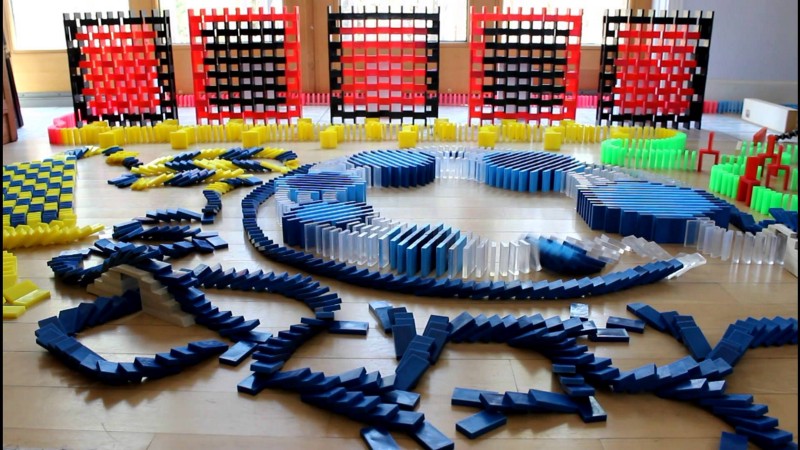
In the brain, this domino effect creates a mismatch of supply and demand — it’s like you frantically scrambling to find that last Tickle Me Elmo Doll in the days leading up to Christmas (Amazon pre-order is your friend).
In other words, the brain needs resources to repair itself but there aren’t enough available. In fact, the amount of resources is actually lower than normal. The result is a short-term “energy crisis” and brain impairment.
This short-term “energy crisis”” is why any concussion/MTBI recovery protocol has an initial 24–48 hour period where you aren’t allowed to be around any stimulus (yes that means no phone and definitely no Twitter — can’t sacrifice even more brain cells to social media). This period reduces stress on the brain while giving it time to recover.
If you want more depth on what happens in your brain during a concussion/MTBI, you can read this. If you’re really feeling frisky and want some Tolkien levels of depth and detail, read this.
Now that we know what’s going on in the brain after a concussion/MTBI, what kind of symptoms does it result in?
III. The Symptoms of a Concussion/MTBI
The symptoms of a concussion/MTBI are multi-factorial and vary from person to person. This spectrum can make concussion/MTBI really hard to treat.
I’ve made a list of the most common symptoms enjoy:
Affective/emotional (can last days to weeks)
- anxiety/nervousness
- irritability
- depression
Cognitive (can last days to weeks, unless otherwise specified)
- confusion (usually lasts minutes to hours)
- difficulty concentrating
- difficulty remembering
- disoriented
- feeling foggy
- feeling slowed down
Sleep (generally, any sleep alteration can last days to weeks)
- drowsiness
- increased sleep quantity
Sensory/physical
- headache (can last from minutes to weeks)
- dizziness (minutes to hours)
- nausea (minutes to hours)
- fatigue (days to weeks)
- light sensitivity (days to weeks)
A few noteworthy symptoms
- vomiting (can last minutes to hours)
- light-headedness
- tinnitus (ringing of the ears)
Here’s the full list if you’re interested.
It’s important to know these symptoms so you can be on the lookout and recognize a potential concussion/MTBI in either yourself, kids, or anyone else.
Now that we’ve covered the basics of concussion/MTBI, let’s get more soccer-specific…
IV. What are the Common Causes & Risk Factors for Soccer Concussions
The most common cause of concussion/MTBI in soccer is, by far, colliding with another player.
Soccer may not be categorized as a “collision sport” but there’s a plethora of high-risk contact that goes down due to players competing and jockeying for space in tight areas.
This can include head to head trauma with players battling for aerial supremacy:
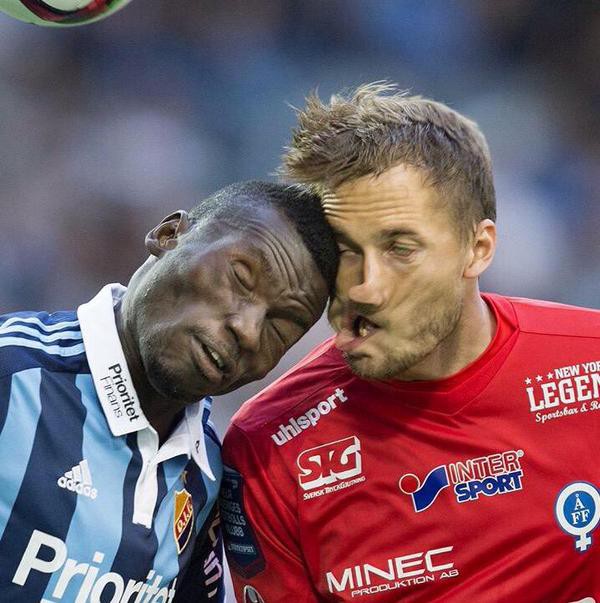
And/or other body parts colliding with the head:
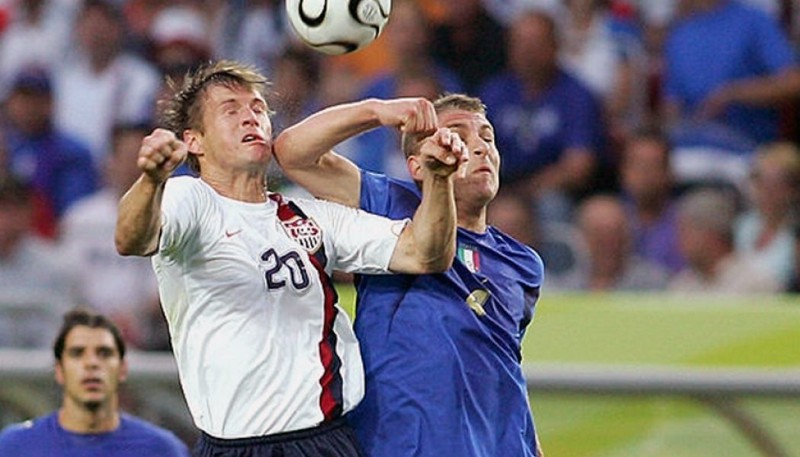
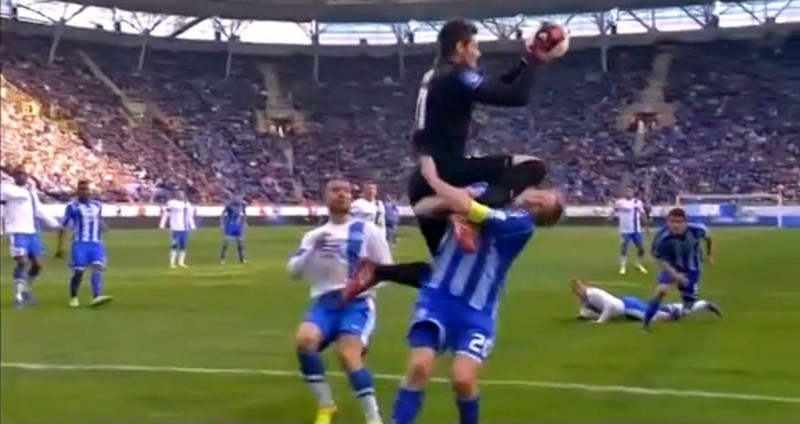
Although concussions/MTBIs represent a large percentage of reported injuries in soccer, two groups are specifically at risk:
Kids and women.
Youth concussion/MTBI rates in soccer are on the rise, with a large-scale study showing a 110% increase over the past 25 years. Additionally, as I said in the opening line, the rate of soccer concussion/MTBI injuries in high school and college players is second only to football.
That rate is even higher in women’s soccer, where concussion rates outpace American football and are nearly 3 times that of men’s soccer. Women’s soccer has the highest concussion rate of any women’s sport, it’s not even close.
But why?
A lower body weight and underdeveloped neck muscles have been shown to make the head and brain more susceptible to acceleration/deceleration forces.
Kids body weight and neck musculature aren’t nearly as developed as adults. Head size is nearly 90% of its full size by 4 years-old, but the body lags far behind. Additionally, kids aren’t as adept at bracing for impact during headers, which increases the amount of force imparted to the brain.
Women, in comparison to their male counterparts, also have lower body weight and less development in their neck muscles.
The intersection of these two groups, young female soccer players, likely explains why concussion/MTBI rates are so high in that demographic. It’s a double whammy.
So how are we guarding against and diagnosing concussion/MTBI? Currently, two key safeguards exist….
V. Soccer Concussion Safeguards
Baseline concussion/MTBI testing
Concussion/MTBI baseline testing can be done prior to the start of a season. It establishes baselines on balance and cognitive function (things like learning and memory skills, ability to concentrate, problem-solving) for athletes.
It often includes a physical test of balance in addition to an automated component, like this:
Commonly used baseline tests include the ImPACT, SCAT5, and Multimodal.
After a head injury or suspected head injury, athletes re-take the test and that score is compared to the previously established baselines. This gives an objective measure of deficits and the likelihood of concussion/MTBI.
Most sports medicine specialists support the use of these tests for athletes participating in contact or collision sports. The US Soccer Federation uses ImPACT testing, but the decision to use baseline testing is left up to the individual schools, leagues, and organizations.
Objective data is critical to diagnose and understand a nebulous condition like concussion/MTBI that can result in different and varying degrees of symptoms for every person.
If you or your kid are part of a league, I highly recommend pushing for baseline concussion/MTBI testing for the team and if that isn’t possible, go to your primary care provider and request it.
However, if neither baseline testing or going to your PCP is possible, then it’s even more important that you understand the signs, symptoms, and potential causes of a concussion, especially as kids are getting smarter and better at beating the system.
I’ve heard stories of kids purposely testing poorly on baseline tests or lying to get back in the game, like what happened on the show Coach Snoop. One of Snoop’s players got hit during a game, was clearly woozy, and then lied to try to get back in the game. Snoop stepped in and refused to let him play, forcing the kid to go through concussion protocol.
As parents or coaches, it’s our responsibility to make those calls on the sidelines. Fortunately, rather than guessing, there’s a cheap and easy-to-use test that can help.
King-Devick Test
The King-Devick test is a quick and accurate test that aids in diagnosing a concussion. It takes less than 5 minutes to complete.
Here’s a video that explains the test and how to use it:
There’s increasing research showing that it’s a good standalone indicator of concussion/MTB that can be viably used by non-medical personnel, including parents of young athletes.
Although best practice still says to use the King-Devick test in conjunction with more formal concussion testing, we don’t live in an ideal world (shocking, I know).
With its ease and quickness of use, it’s a really powerful tool for any parent, coach, or responsible bystander who wants to test a player…or irritate your kids for no reason, that’s always fun.
All in all — if you think your kid might have a concussion/MTBI, insist they are taken out of the game or tested on the sidelines. The risk/reward of even an “I think he might have done something to his head but I’m not sure so I’m not going to say anything” completely tilts toward risk.
So that’s one key safeguard, the other is…
Concussion/MTBI education and awareness
Generally, the awareness and seriousness of concussion/MTBI’s have sky-rocketed in recent years, particularly due to high profile cases of concussion/MTBI and CTE findings in the NFL.
This increase in general awareness must also be met with an increase in local awareness — meaning education to parents and players alike about the signs, symptoms, and risks of a concussion/MTBI.
To that end, a huge step was taken by the US Soccer Federation with their Concussion Initiative, part of which was the heading modification rules we talked about before. Additionally, the initiative provides information, guidelines, and resources to “players, parents, team/club staff and coaches and referees.”
Further, soccer youth organizations like AYSO have begun requiring their coaches and referees to complete the CDC’s online concussion/MTBI awareness training, while encouraging section, area, and region board members to do the same.
Additionally, AYSO provides a concussion/MTBI information sheet to “inform all parents and players about the signs and symptoms of concussion and the associated risks”.
The tide is certainly turning when it comes to being aware of concussion/MTBIs. However, has that actually resulted in increased detection and safety?
VI. Are Concussion/MTBI rules and awareness working?
The increased awareness does seem to be working. Multiple studies have attributed the increase in concussions/MTBI incidence to medical providers, parents, athletes, and coaches being more aware of, looking out for, and reporting potential concussion/MTBI.
Dr. Morteza Khodaee, an assistant Family Medicine professor at the University of Colorado’s School of Medicine, echoed this sentiment as he believes the significant rise in concussions “could be due to better recognition of concussion by medical and coaching staff”.
Additionally, there’s increasing pressure on the top professional soccer leagues to implement better concussion protocols.
UEFA currently allows a 3-minute assessment of a player who’s suspected of having a concussion/MTBI. They’re reportedly considering updating the protocol to allow for medical staff to review incidents with video playback on devices like tablets.
The pressure for increased protocols and sideline playback ratcheted up after a high-profile incident in which Liverpool goalkeeper Loris Karius was concussed during the 2017 Champions League Final against Real Madrid.
The game was never stopped and he never examined. He subsequently made two critical mistakes, both of which could easily have been attributed to concussion/MTBI symptoms.
After the game, he tested positive in 26/30 concussion/MTBI tests. All the while taking grief to form the world, Liverpool supporters, and asking for forgiveness after the match:
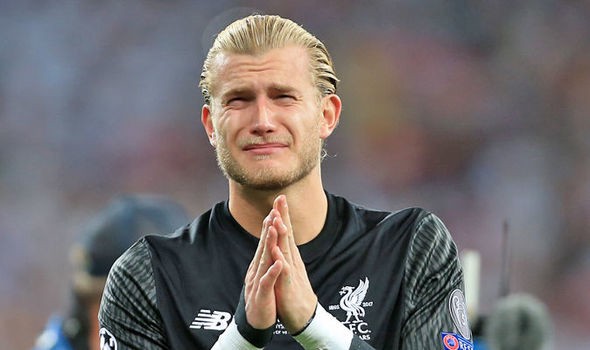
A player who suffered a brain injury and wasn’t taken out of the match like he should have been…yet he’s the one asking for forgiveness? UEFA should be embarrassed.
I wrote about the entire saga here.
However, unlike UEFA, the English Premier League (EPL) has had video rewind and playback of concerning incidents since 2016 — mirroring the head injury assessment process in the Rugby Union.
Further, there are increasing calls to give more time for appropriate concussion/MTBI assessment and allowing for a temporary sub.
Here’s what Dr. Willie Stewart, a British neurosurgeon who has been a champion for improving head injury assessment in soccer and rugby, told BBC Sport:
“Football doesn’t allow an interchange for a player to be assessed to see if he has a brain injury; doesn’t allow significant time for the medics to assess the player; doesn’t have a video review of events to be able to say if there was a glancing blow on my goalkeeper’s head which I didn’t notice.
It’s unacceptable in 2018 that it should be this way.”
100% agreed.
Additionally, Premier League docs are currently at the forefront of demanding change in concussion/MTBI protocol and assessment, asking for the following:
- If a player is suspecting of having a concussion/MTBI, they are allotted 10 minutes off the field for further assessment
- In those 10 minutes, a temporary substitute is allowed. If a concussion/MTBI is confirmed, the temporary sub becomes permanent
- The addition of a 4th substitute in cases where a player has to be taken off due to concussion/MTBI
The overall point of these is, first and foremost, to increase player safety. Additionally, these changes would decrease the pressure on medical staffs to rush to judgement regarding a concussion/MTBI diagnosis and decrease the pressure on players, especially goalkeepers, to stay in the game after a head injury.
Personally, I’m all for it. A slight upset in the flow of the game is worth exponentially improving player safety and head injury assessment.
Of course, there will be the “traditionalist” detractors but there always are. Remember when people were complaining that goal-line technology and VAR would upset the flow and beauty of the game?
Times change, technology improves — we can harness it to improve player safety while minimally changing the flow of the game.
VII. The Takeaway
Soccer may be considered a “non-collision” sport but that doesn’t mean it’s a non-concussion/MTBI sport.
Don’t let Neymar and other dudes rolling around like they just got hit by sniper fire rather than grazed by a toe (if that) fool you — soccer is a contact sport that comes with a real risk of concussion/MTBI.
The full extent of that risk is still TBD as ongoing research explores the potential cumulative and insidious effects of headers and “sub-concussive” impacts.
In general, I’m thrilled that there’s a growing trend towards pre-cautionary measures — led by the US Soccer Federation and the English Premier League.
Their proactive approach to concussion/MTBI policies is key to shifting the general conversation and making change more palatable while putting pressure on other leagues and governing bodies to implement similar policies.
Whether you’re a fan, player, parent, coach, or ref, now’s not the time to cover your eyes and ears when it comes to brain injuries in soccer. It’s time to understand what’s happening, why it’s happening, and make the requisite changes needed so we can all enjoy the sport for years to come.
The last thing we want to do is to turn a blind eye to the issue, as we’ve done with the NFL. We can’t wait until former players are using suicide as a last-ditch effort to give a face to long-standing faceless issue to act. It’s on us to do something now.















